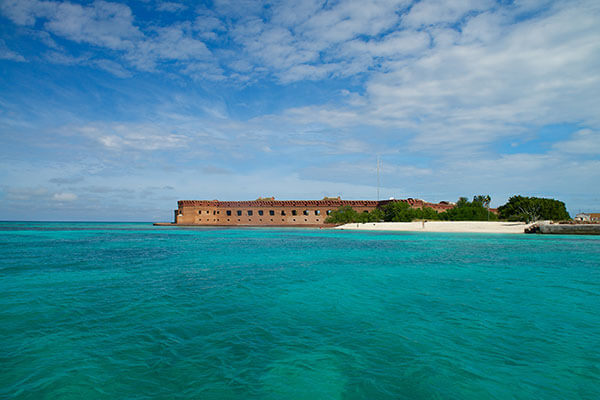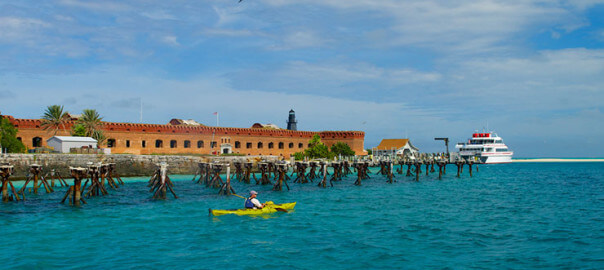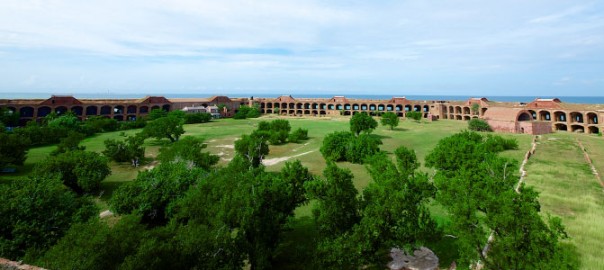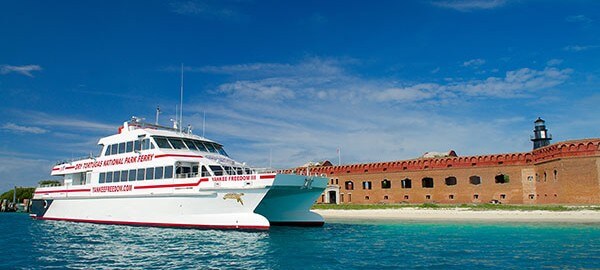Forbidding fortress set amid splendor of Keys

NorthJersey.com – The Washington Post
By Fergus Bordewich
Published: December 24, 2011
Our first sight of Fort Jefferson from our excursion boat, the Yankee Freedom, was of a thin dark scratch across the teal surface of the Gulf of Mexico. As we drew nearer, the fort’s massive brick walls seemed to float on the sea, majestic and forbidding, filling almost the entire 10 acres of Garden Key, the largest of the islets known as the Dry Tortugas.
Finally, we’d arrived at the place I’d wondered about for more than 50 years, ever since, as a child, I’d seen “The Prisoner of Shark Island,” John Ford’s riveting (if pro-Confederate) 1936 film about Samuel Mudd, the physician who set John Wilkes Booth’s broken leg during his flight into Maryland after the assassination of Abraham Lincoln. Subsequently convicted of conspiracy, Mudd became the fort’s most notorious prisoner, confined in what seemed on screen like a hellish limbo at the edge of the Earth. After planning a trip to Key West, Fla., with our daughter, Chloe, my wife, Jean, and I were delighted to discover that we could easily make a day trip to the fort.
We’d left Key West at 8 a.m. Two-and-a-half hours later, we were docking and crossing the fort’s moat — once patrolled by sharks — on a plank bridge. We passed through an arched gate onto the vast hexagonal parade ground, studded with gnarled buttonwood and gumbo-limbo trees and ringed by three tiers of casements, or gun rooms, some of them still mounted with cannons.
We toured the fort first with a guide approved by the National Park Service, which maintains the site, and then on our own, using a short history of the fort, “America’s Fortress,” available in the small museum. We wandered among the casements and peered through their gun ports at the shimmering vastness of the gulf. It was utterly empty but for the sandy scraps of the six other Tortugas — the islets were named by early Spanish explorers for the abundance of turtles they found — and a colony of brown pelicans perched like portly sentinels on the ruins of coaling docks dating from the Spanish-American War.
Once known as “America’s Gibraltar” and still the largest masonry structure in the Western Hemisphere, Fort Jefferson was a linchpin of the United States’ first comprehensive national defense system. It protected the sea route between the East Coast and Gulf of Mexico ports, deterring invasion at a time when Britain and Spain were considered serious foreign threats. During the Civil War, it was one of the few Southern forts to remain in Union hands. Although it was designed to mount 450 guns, only about 75 were ever installed. But that was sufficient: The Confederacy never dared to attack.
During the war, the fort served primarily as a prison for Union soldiers convicted of crimes ranging from murder and pillaging to falling asleep on guard duty. Only a handful of prisoners, such as Mudd and the other men — Michael O’Laughlin, Samuel Arnold and Edward Spangler — imprisoned in the Dry Tortugas for their connections to Booth, were classed as traitors.
Mudd, an unapologetic slave owner, regarded himself as a martyr to Yankee tyranny. Engraved over the entrance to the casement where he lived is a quote from Dante’s “Inferno”: “Whoso Entereth Here Leaveth All Hopes Behind.” In his letters home, Mudd complained piteously of “degrading” punishment and “inhuman” conditions, citing among other things the shame of being guarded by black soldiers.
In fact, according to our guide and “America’s Fortress,” apart from a brief period after he tried to escape, Mudd was allowed to move freely around the fort, and to earn money for luxuries such as tobacco and civilian clothing by making boxes and picture frames inlaid with sea shells that he sold to officers and visitors to the fort. One Christmas, Mudd wrote home that he had dined on roast turkey, oysters, fresh peaches and other treats.
The Union prisoners and their guards shared virtually all Mudd’s discomfort. The official rations were generally abysmal: Meat was often rancid, bread infested with bugs and the water with wriggling worms. Malaria, dysentery, cholera, sunstroke and other ailments were chronic. Isolation bred excruciating loneliness. Men went mad almost as a matter of course. As Harrison Herrick of the 110th New York noted in his diary, displayed in the museum, “One of the guards, one of the Del. Artillery shot himself through the head. He was crazy. Wether fair and plesant.”
Mudd owed his eventual release in part to the role he played during a horrific yellow fever epidemic that swept Fort Jefferson in 1867. Scores died, including the post doctor and most of the male nurses. Bravely, Mudd managed the infirmary almost single-handedly for the duration of the epidemic. Survivors petitioned the government for his freedom. On Feb. 8, 1869, having served only four years of his life sentence, he was pardoned by President Andrew Johnson. (Arnold and Spangler were also pardoned around the same time; O’Laughlin died in prison.) Mudd retired to his Waldorf, Md., farm, where he lived out the rest of his life as far from the public eye as he could get.
In the brilliant sunshine of an August afternoon, the fort’s strange, dark history seemed remote and unreal. Eventually we too succumbed to the cheerier seductions of the abundant coral and polychrome schools of darting fish that make their home in the crystalline waters outside the fort’s walls. (The beach here is one of the finest sites for snorkeling in the gulf.)
Before our boat departed, however, I left Jean and Chloe to the undersea world to return once more to the fort for a final walk-through. In one of the casements, I noticed a small fiberglass boat crudely patched with aluminum and powered by an ancient automobile engine. A park ranger told me that 15 refugees had sailed it from Cuba. Over the years, he added, thousands of Cubans have made their first American landfall here in the largely unpatrolled Dry Tortugas. They’re still coming. Another group had arrived just three weeks before our visit.
How ironic, I thought, that one of the most notorious prisons in the United States had become, in the 21st century, a goal for those seeking freedom.




